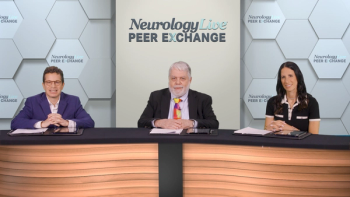
Appropriate Diagnosis and Management of RRMS
The patient symptoms that help neurologists distinguish relapsing and remitting multiple sclerosis from other forms of the disease, and recommendations regarding the best timing to initiate therapy.
Episodes in this series

Jennifer Graves, MD, PhD, MAS: Hello, and welcome to this Neurology Live® Peer Exchange titled “Oral Therapy Options for Relapsing-Remitting Multiple Sclerosis.” I’m Dr Jennifer Graves. I’m an associate professor of neurosciences and the director of neuroimmunology research at the University of California San Diego. Joining me for this discussion are my colleagues Dr Gabrielle Macaron, a neurologist and neuroimmunologist at Hôtel-Dieu de France hospital at Saint Joseph University in Beirut, Lebanon, and adjunct staff at the Mellen Center for Multiple Sclerosis Treatment and Research at the Cleveland Clinic in Ohio. Also joining me is Dr Suma Shah, an assistant professor of neurology at Duke University School of Medicine in Durham, North Carolina. Welcome, both of you. Let’s get started.
Before we dive into treatment considerations, I’d like to hear both of you give your impressions and the way you communicate to patients. What’s the presentation and diagnosis of relapsing-remitting multiple sclerosis [RRMS]? Maybe we can start with Dr Shah.
Suma Shah, MD: Relapsing-remitting multiple sclerosis is the most prevalent type of multiple sclerosis [MS] that we encounter as neuroimmunologists. I often tell patients that this is very heterogeneous in its presentation. There are different ways it can cause the brain or spine to not behave correctly and leave scars that leave lingering effects for what can be years. Because of the individual nature of the disease, it’s important to listen for that story of something changing in how someone’s body works—improving with time and then perhaps something else happening. As I describe it, the hallmark of RRMS is that separation in time and space that we talk about in multiple sclerosis of different areas of the brain and spine being affected and causing a change in how someone’s body works.
Jennifer Graves, MD, PhD, MAS: Dr Macaron, would you like to add to that?
Gabrielle Macaron, MD: Yes, I’d like to add that relapses typically include optic neuritis and transverse partial myelitis. Basically, any lesions in the spinal cord or brain can cause symptoms. Unfortunately, some patients don’t recover well from those relapses. Most do, but some don’t, and they’re going to accumulate disability. Over time, this can be a problem, especially in an untreated patient, so it’s key to diagnose patients early on in the disease course. The modifications in the 2017 McDonald [Criteria for the Diagnosis of Multiple Sclerosis] allow for earlier diagnosis and help us address the disease earlier on in the disease course.
Jennifer Graves, MD, PhD, MAS: Dr Macaron, do you initiate therapy on all patients in whom you make the diagnosis of relapsing-remitting MS?
Gabrielle Macaron, MD: In recently diagnosed patients, especially young adults with active multiple sclerosis, it’s important to initiate therapy early to control the inflammation early in the disease course. There are many arguments for this approach. First, we know that the disease is mostly active in the first 5 years, and that’s the window of efficient treatment that we don’t want to miss if we want to offer our patients the best long-term outcomes. There are a number of publications that have covered this issue, and we know that DMTs [disease-modifying therapies] are most effective early in the disease course.
Also, most patients end up having new lesions or developing relapses if we don’t treat them. This is the natural course of the disease in most patients. We know that benign MS is something that exists, but unfortunately, it remains a rare entity and we can’t predict who’s going to have benign MS. If we could, we could have spared some patients of treatment. But we can’t, so it’s better to treat everybody, because most patients will end up having relapses and new lesions and accumulating disability.
Jennifer Graves, MD, PhD, MAS: Dr Shah, what is the importance of treating as early as possible?
Suma Shah, MD: The heterogeneity and potential risks of debility that can accumulate over time are strong factors in making treatment decisions early. There’s a lot that’s being said about induction vs escalation therapy, but for all the reasons Dr Macaron just mentioned, the right answer is that everybody should at least be offered and have a conversation about their potential treatment options. But with 24 and counting potential options for treatment, there’s no wrong answer, other than, “I don’t want to take anything.” That’s a valuable conversation to sit down with someone and understand what the patient’s interested in and what the potential implications might be of withholding treatment if we don’t start it right away.
Jennifer Graves, MD, PhD, MAS: Is there any type of presentation that would make you feel comfortable waiting or delaying early treatment? Do you think there’s any such thing as truly benign MS? Is there any patient that you could imagine in whom you wouldn’t want to initiate early therapy?
Suma Shah, MD: That’s a great question. I think back to the patients I haven’t started on therapy right away, and it’s because they either don’t meet criteria for relapsing-remitting MS right away—they present with optic neuritis or transverse myelitis—or they have other medical comorbidities that take precedence over treatment. For example, I had someone last year who was diagnosed with CNS [central nervous system] lymphoma at the same time as a new diagnosis of MS. His lymphoma treatment took precedence there. Those stories are case by case.
Gabrielle Macaron, MD: We all have patients who come and see you 20 years after their diagnosis who weren’t treated. Benign MS is a retrospective diagnosis. For those patients, they always make me wonder, what if I treated this patient for 20 years? What if I exposed this patient to adverse effects and the cost of treatment and they ended up having benign MS? Unfortunately, those patients remain a minority of patients, and we can’t predict that. For the 85% or more of patients who don’t have benign MS, it’s worth treating everybody.
Suma Shah, MD: Absolutely.
Jennifer Graves, MD, PhD, MAS: I agree. I don’t know if it’s been validated in a more modern cohort with modern treatments, but there were data awhile ago that defined benign MS. At least 50% of people who might have met that old definition of benign MS went on to have nonbenign MS, so even those who look benign have a significant risk of not staying benign over time.
Thank you for watching this Neurology Live® Peer Exchange. If you enjoyed the content, please subscribe to our e-newsletters to receive upcoming Peer Exchanges and other great content right in your in-box.
Transcript edited for clarity.
Newsletter
Keep your finger on the pulse of neurology—subscribe to NeurologyLive for expert interviews, new data, and breakthrough treatment updates.


























